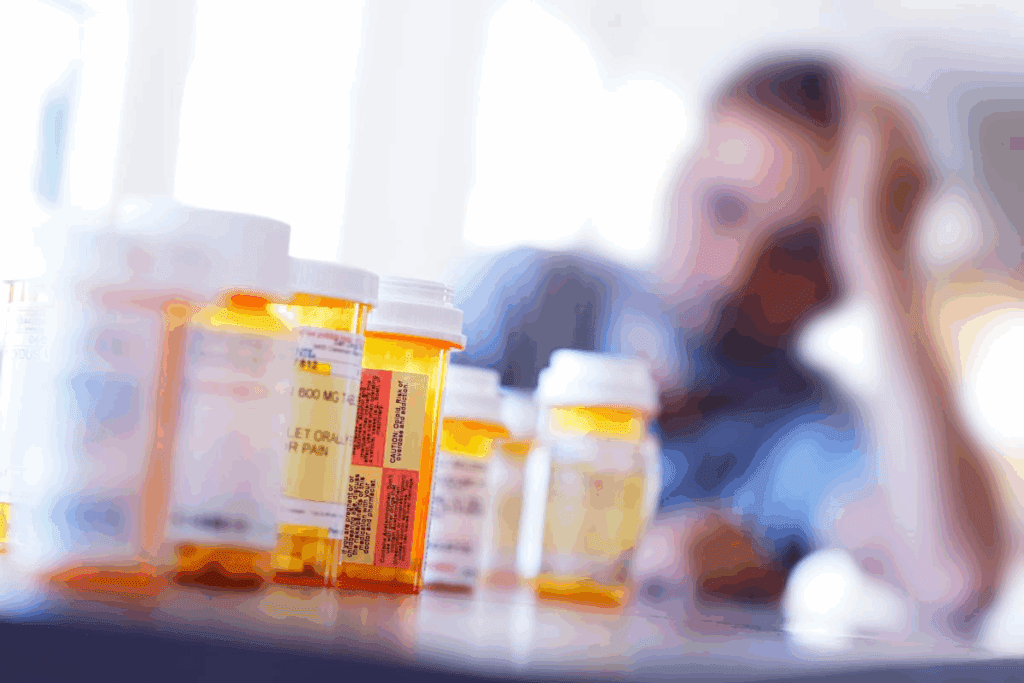
Managing irregular heartbeat is key to a better life. At Liv Hospital, we focus on advanced care for arrhythmia patients. We use the latest medical protocols and multidisciplinary expertise for the best results.Learn 8 most common drugs for arrhythmia to treat irregular heartbeat effectively.
Choosing the right medication is vital for controlling irregular heart rhythms. We stress the need to know the different types of medications. These include antiarrhythmic drugs, rate control medications, and anticoagulants.
Our team at Liv Hospital is dedicated to personalized care. We make sure each patient gets the right treatment for their condition. By keeping up with the latest in heart arrhythmia medications, we help our patients manage their condition well.

It’s key to understand cardiac arrhythmias to manage their health impact. These occur when the heart beats irregularly, too fast, or too slow. This disrupts its normal rhythm.
There are many types of arrhythmias, each unique. Atrial fibrillation is common, where the upper heart chambers beat irregularly. Tachycardias mean a heart rate that’s too fast, while bradycardias mean it’s too slow. Premature beats happen when the heart beats too early.
Symptoms of arrhythmias vary. Common ones include palpitations, dizziness, and shortness of breath. If not treated, arrhythmias can cause serious issues like stroke and heart failure. This shows why getting the right treatment is so important.
If symptoms get worse or don’t go away, see a doctor. Severe symptoms like chest pain, severe dizziness, or difficulty breathing need quick help. Early treatment can greatly help those with arrhythmias.
At our institution, we focus on caring for arrhythmia patients. Our skilled cardiologists work with patients to create treatment plans that meet their needs.

In managing arrhythmias, drugs for heart arrhythmia are key. They help control symptoms and prevent strokes. At our institution, we tailor medication therapy to improve patient outcomes.
The main goals of arrhythmia treatment medication are to control symptoms and prevent complications. This improves the patient’s quality of life. By managing irregular heart rhythms, we reduce the risk of complications.
There are two main strategies in arrhythmia management: rhythm control and rate control. Rhythm control aims to restore a normal heart rhythm. Rate control focuses on controlling the heart rate to prevent symptoms and complications. The choice depends on the patient’s condition, symptoms, and medical history.
Preventing stroke is critical in arrhythmia management, mainly for patients with atrial fibrillation. Anticoagulants are vital in preventing stroke by reducing blood clot formation. We assess each patient’s risk factors to determine if anticoagulant therapy is needed.
We use different types of medications to manage arrhythmias. These include antiarrhythmic drugs, rate control medications, and anticoagulants. Each type helps in treating various aspects of arrhythmias.
Antiarrhythmic drugs are divided into four classes. Class I drugs, like flecainide and propafenone, block sodium channels. Class II drugs, such as metoprolol, reduce sympathetic stimulation. Class III drugs, including amiodarone and sotalol, block potassium channels, extending the action period. Class IV drugs, like verapamil and diltiazem, slow AV node conduction.
A study in the Journal of the American College of Cardiology found that antiarrhythmic drugs are key in treating atrial fibrillation.
“The choice of antiarrhythmic drug depends on the type of arrhythmia, the presence of structural heart disease, and the patient’s symptoms and preferences.”
| Class | Mechanism of Action | Examples |
| I | Sodium channel blockade | Flecainide, Propafenone |
| II | Beta-blockade | Metoprolol, Propranolol |
| III | Potassium channel blockade | Amiodarone, Sotalol |
| IV | Calcium channel blockade | Verapamil, Diltiazem |
Rate control medications help manage heart rate in arrhythmias, like atrial fibrillation. Beta-blockers and calcium channel blockers are the main types. They slow AV node conduction, reducing ventricular rate.
Anticoagulants prevent stroke in atrial fibrillation patients. They stop the coagulation cascade, reducing thrombus risk. Common ones include warfarin, apixaban, rivaroxaban, and dabigatran.
The right anticoagulant depends on stroke risk, renal function, and drug interactions. Warfarin needs regular INR checks, while DOACs like apixaban and rivaroxaban offer predictable anticoagulation without monitoring.
| Anticoagulant | Mechanism | Advantages | Disadvantages |
| Warfarin | Vitamin K antagonist | Effective, reversible | Requires INR monitoring, dietary restrictions |
| Apixaban | Factor Xa inhibitor | No routine monitoring, fewer drug interactions | Higher cost, no reversal agent (though being developed) |
| Rivaroxaban | Factor Xa inhibitor | Once-daily dosing, effective | Higher cost, drug interactions |
For many patients with arrhythmias, beta-blockers are a key treatment. They help regulate heart rhythm and improve heart function. These drugs slow the heart rate and reduce contraction force.
Bisoprolol and atenolol are two beta-blockers often used for arrhythmias. Bisoprolol targets beta-1 receptors, reducing heart rate without affecting breathing or blood flow. Atenolol has been used for decades to control heart rate, helping patients with certain arrhythmias.
Beta-blockers block adrenaline’s effect on the heart. This slows the heart rate and reduces contraction force. This is key in managing arrhythmia symptoms like palpitations and shortness of breath. Studies show beta-blockers effectively control heart rate and improve symptoms.
Beta-blockers are generally safe but can have side effects. Common ones include fatigue, dizziness, and cold hands or feet. Serious side effects like slow heart rate or heart failure can occur in some. It’s vital for patients to be closely monitored by their healthcare provider.
“Beta-blockers are a cornerstone in the treatment of many arrhythmias, providing a vital solution for managing irregular heartbeats.”
Liv Hospital Cardiologists
At Liv Hospital, our cardiologists weigh the benefits and risks of beta-blockers for each patient. We ensure personalized care and effective arrhythmia management.
We use calcium channel blockers to treat arrhythmias. They help control the heart rate and rhythm. These drugs block calcium ions in heart and blood vessels, reducing heart rate and easing arrhythmia symptoms.
Diltiazem is a key calcium channel blocker. It’s used for supraventricular tachycardia and controlling ventricular rate in atrial fibrillation or flutter. It’s great for lowering heart rate without changing to a normal rhythm.
Verapamil is another calcium channel blocker for rate control in arrhythmias. It’s also good for angina and hypertension. This makes it a versatile choice for patients with heart conditions.
But, verapamil can have side effects like constipation and heart weakening. These effects might limit its use in heart failure patients.
Calcium channel blockers like diltiazem and verapamil are mostly safe. But, they can cause problems. Common side effects include:
Choosing the right patients and monitoring them closely is vital. This helps avoid side effects and ensures the drugs work well for arrhythmias.
For patients with complicated arrhythmia cases, amiodarone is often the first choice. At our institution, we’ve seen it work well for many types of arrhythmias. It’s a valuable option for those with complex cases.
Amiodarone is special among antiarrhythmic drugs because it works on many types of arrhythmias. It treats both supraventricular and ventricular arrhythmias. Its unique mechanism of action involves multiple ion channels, making it effective for various arrhythmias.
Amiodarone is used for many conditions, from atrial fibrillation to ventricular tachycardia. It’s great at keeping the heart in rhythm, even in patients with atrial fibrillation. We often choose amiodarone for patients who haven’t responded to other treatments or can’t take other medications.
While amiodarone is very effective, long-term use needs careful thought. It can cause thyroid problems, lung issues, and liver damage. We watch patients closely to reduce these risks.
To manage side effects, we use regular monitoring. This includes tests for the thyroid, liver, and lungs. By watching patients closely, we can adjust the treatment if needed.
Monitoring is key for patients on amiodarone. Here’s what we recommend:
| Test | Frequency | Purpose |
| Thyroid Function Tests | Every 6 months | To detect thyroid dysfunction |
| Liver Function Tests | Every 6 months | To monitor liver health |
| Pulmonary Function Tests | Annually | To assess lung function |
| ECG | At each follow-up | To monitor heart rhythm |
Following this schedule helps us use amiodarone safely and effectively for complex arrhythmias.
Supraventricular arrhythmias can be managed well with flecainide, a special antiarrhythmic drug. We at our institution see the value of targeted treatments for irregular heartbeats. Flecainide is a key option for many patients.
Flecainide blocks sodium channels in the heart. This slows down electrical impulses. It’s key in treating supraventricular arrhythmias, helping the heart beat normally.
By blocking sodium channels, flecainide lowers the heart’s automaticity. This targeted approach helps manage arrhythmia symptoms more precisely.
Flecainide is mainly for treating supraventricular arrhythmias. This includes paroxysmal atrial fibrillation/flutter and paroxysmal supraventricular tachycardia. Studies show it’s effective in keeping the heart rhythm normal.
| Indication | Effectiveness Rate | Common Side Effects |
| Paroxysmal Atrial Fibrillation/Flutter | 70-80% | Dizziness, Headache |
| Paroxysmal Supraventricular Tachycardia | 80-90% | Fatigue, Palpitations |
Flecainide is effective but not for everyone. Those with heart conditions or significant left ventricular dysfunction may face risks.
Contraindications include:
We evaluate each patient’s condition to decide if flecainide is right for them. Understanding risks and benefits helps us tailor care to each patient’s needs.
Sotalol is a powerful drug for treating ventricular arrhythmias. It works in two ways: as a beta-blocker and by blocking potassium channels. This makes it very effective.
Sotalol’s strength comes from its two actions. It slows the heart rate and makes each beat weaker. This lowers the heart’s need for oxygen. It also blocks potassium channels, which helps keep the heart rhythm steady.
Key Benefits of Sotalol’s Dual Action:
Sotalol is great for treating many arrhythmias, like ventricular ones. It’s flexible and meets different patient needs.
| Arrhythmia Type | Sotalol’s Role | Benefits |
| Ventricular Tachycardia | Controls rapid heart rhythms | Prevents potentially life-threatening arrhythmias |
| Ventricular Fibrillation | Helps stabilize heart rhythm | Reduces risk of sudden cardiac death |
| Atrial Fibrillation | Can be used for rhythm control | Improves symptoms and quality of life |
Watching the QT interval is key when using sotalol. A long QT interval can lead to dangerous arrhythmias like Torsades de Pointes.
Regular ECG monitoring is essential for safe sotalol use. We suggest regular check-ups to keep an eye on the QT interval and adjust the dose if needed.
Understanding how sotalol works and monitoring its effects helps manage ventricular arrhythmias. This improves patient outcomes.
Dronedarone is a new choice for treating atrial fibrillation. It’s different from older drugs like amiodarone. Atrial fibrillation is a complex condition, and dronedarone is a valuable new option.
Dronedarone and amiodarone work in similar ways to keep the heart in rhythm. But dronedarone was made to have fewer side effects than amiodarone. It doesn’t have the iodine that can harm the thyroid and lungs.
Key differences between dronedarone and amiodarone include:
| Characteristics | Dronedarone | Amiodarone |
| Iodine Content | No | Yes |
| Half-life | Shorter (13-19 hours) | Longer (58 days) |
| Thyroid Toxicity | Less likely | More common |
| Pulmonary Toxicity | Rare | Possible |
Dronedarone has fewer side effects than amiodarone, like thyroid and lung problems. It’s also easier to tolerate for some patients. But, it’s not as good at keeping the heart in rhythm as amiodarone. It’s also not for everyone, like those with advanced heart failure.
Choosing the right patients for dronedarone is key. We look at their medical history, how bad their atrial fibrillation is, and if they can handle other heart drugs. Those with heart failure or at risk of organ damage are not good candidates. But, those who can’t handle amiodarone’s side effects might do well with dronedarone.
In conclusion, dronedarone is a good choice for managing atrial fibrillation. It balances safety and effectiveness. By picking the right patients and watching how they do, we can make the most of dronedarone while avoiding its risks.
For those with arrhythmias, anticoagulants are key. Atrial fibrillation raises stroke risk. Anticoagulants help lower this risk, improving patient health.
Warfarin has long been used to prevent strokes in atrial fibrillation patients. It’s effective but needs regular INR checks. We help manage this, adjusting doses to keep INR in range.
Key considerations for warfarin therapy include:
Direct oral anticoagulants (DOACs) like apixaban offer alternatives to warfarin. They have fewer monitoring needs and less dietary restrictions. Apixaban is effective in preventing strokes and is safe.
The benefits of DOACs like apixaban include:
Preventing strokes in arrhythmia patients requires a detailed plan. We look at risk factors like the CHA2DS2-VASc score to choose the best treatment. This approach reduces stroke risk and improves health outcomes.
Our approach to stroke prevention includes:
Personalization is key in treating arrhythmia, making sure each patient gets the right care. At Liv Hospital, we know every patient is different. So, we tailor our approach to fit their needs.
Choosing the right medication for arrhythmia depends on several things. These include the type and severity of the arrhythmia, the patient’s health history, and their lifestyle. Our cardiologists work closely with patients to understand their specific needs and develop a treatment plan that is tailored to their condition.
For example, patients with other health issues might need medications that help with both their arrhythmia and other conditions. “The right medication can make a big difference in managing arrhythmias and improving quality of life,” says one of our cardiologists.
Sometimes, one medication isn’t enough to manage arrhythmias. That’s when combination therapy comes in. By mixing different medications, we can tackle the arrhythmia from different angles, improving management.
Our team carefully weighs the benefits and risks of combination therapy for each patient. We make sure the treatment plan is both effective and safe.
Medication isn’t the only thing that helps manage arrhythmias. Lifestyle changes are also important. We advise patients on diet, exercise, and stress management to help their treatment.
A healthy lifestyle not only improves heart health but also makes treatment more effective. By making smart choices, patients can play a big role in their care, leading to better results.
In conclusion, a personalized approach to arrhythmia treatment is vital. It includes choosing the right medication, using combination therapy, and making lifestyle changes. This is essential for the best patient outcomes.
Managing arrhythmias well needs a full plan that includes the right medicine. There are many types of drugs, like antiarrhythmic drugs and rate control medications. These help control symptoms and prevent serious problems.
At Liv Hospital, we focus on giving each patient the care they need. We make sure they get the best medicine for their arrhythmia. Our team of cardiologists works closely with patients to improve their health and life quality.
Finding the right medicine for an irregular heartbeat is key. It can lower the chance of stroke and other serious issues. We aim to provide top-notch care to all our patients, including those from abroad. Our goal is to ensure they get the best treatment for their condition.
To treat arrhythmias, doctors use three main types of drugs. These are antiarrhythmic drugs, rate control medications, and anticoagulants. Antiarrhythmic drugs are split into classes based on how they work.
Beta-blockers are key in managing arrhythmias, mainly by controlling heart rate. They block adrenaline’s effect on the heart. This slows the heart rate and lessens the force of each beat.
Calcium channel blockers, like diltiazem and verapamil, help manage heart rate and symptoms in arrhythmia patients. They slow the heart’s electrical impulses.
Amiodarone is a powerful drug for complex arrhythmias. It’s effective for many types of arrhythmias but long-term use can have side effects.
Anticoagulants, such as warfarin and apixaban, prevent strokes in atrial fibrillation patients. They stop blood clots that could cause a stroke.
Choosing the right anticoagulant depends on the patient’s health, risks, and lifestyle. Our cardiologists work with patients to find the best treatment.
Yes, lifestyle changes can help with medication therapy for arrhythmias. Our cardiologists help patients create plans that improve heart health and overall well-being.
A personalized approach ensures patients get the best treatment for their arrhythmia. Their medical history, symptoms, and lifestyle guide medication choices. Sometimes, combining treatments is needed for effective management.
Side effects of antiarrhythmic drugs vary by medication. For example, beta-blockers might cause fatigue, dizziness, or shortness of breath. Amiodarone can lead to thyroid issues, lung problems, or skin discoloration.
Patients on these medications are closely watched for side effects and treatment success. Regular check-ups with our cardiologists are key to adjusting treatment as needed.
Subscribe to our e-newsletter to stay informed about the latest innovations in the world of health and exclusive offers!
WhatsApp us